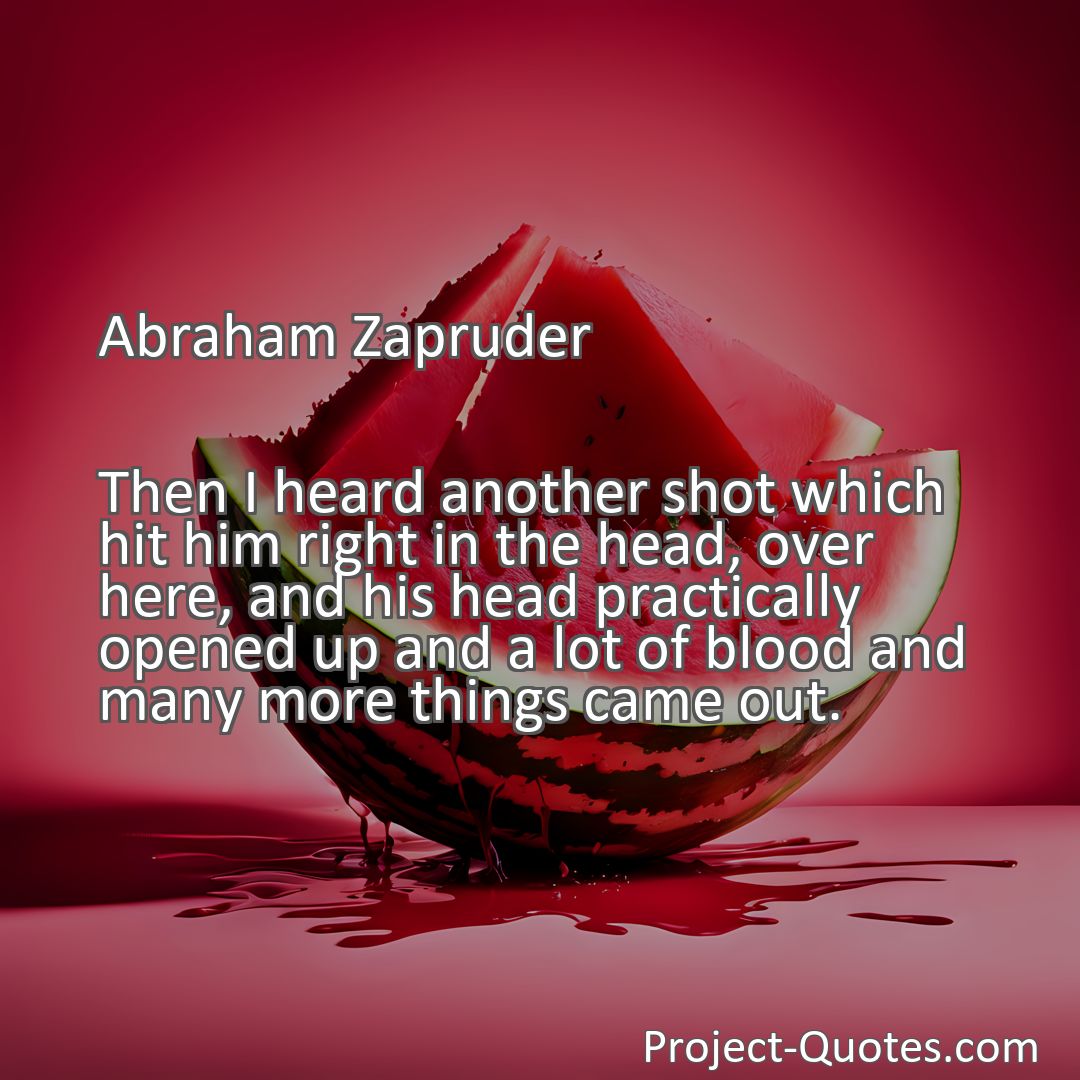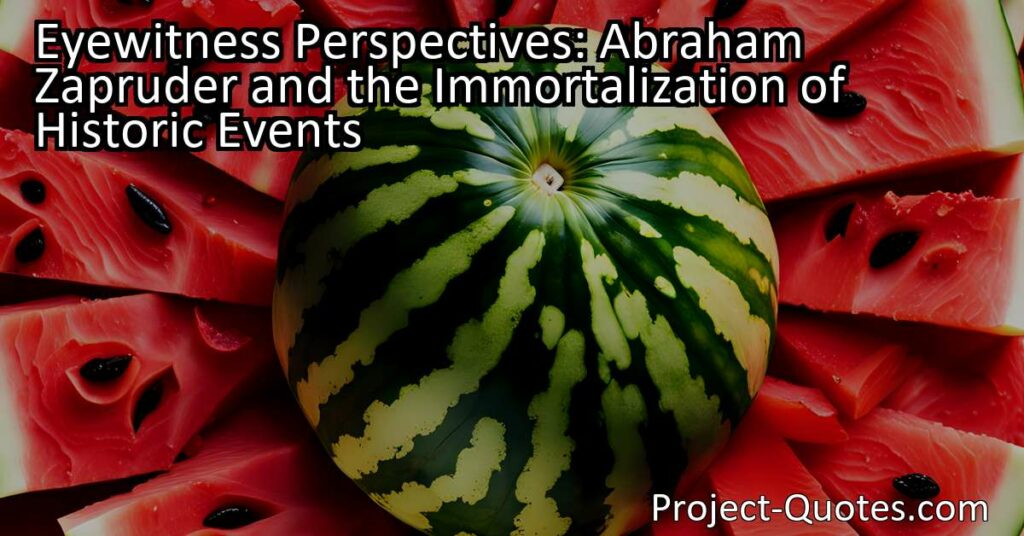Then I heard another shot which hit him right in the head, over here, and his head practically opened up and a lot of blood and many more things came out.
Abraham Zapruder
Eyewitness Perspectives: Abraham Zapruder and the Immortalization of Historic Events Abraham Zapruder’s haunting and vivid account of President Kennedy’s assassination offers an intimate and chilling glimpse into the tragic events that unfolded before his eyes. Through his eyewitness testimony and the iconic Zapruder film, Zapruder’s perspective became a catalyst for shaping the public’s understanding of this historic event, immortalizing it in the annals of history. Eyewitnesses like Zapruder play a crucial role in capturing and preserving the essence of significant moments, ensuring that they are always remembered.
Table of Contents
- 1 Then I heard another shot which hit him right in the head, over here, and his head practically opened up and a lot of blood and many more things came out.
- 2 Abraham Zapruder
- 3 Meaning of Quote – Then I heard another shot which hit him right in the head, over here, and his head practically opened up and a lot of blood and many more things came out.
- 4 Freely Shareable Quote Image
- 5 Related
Meaning of Quote – Then I heard another shot which hit him right in the head, over here, and his head practically opened up and a lot of blood and many more things came out.
A Grave Encounter: The Enigmatic Perspective of Abraham Zapruder
Introduction
In the realm of historical documentation, few accounts can rival the chilling and intimate recollections of eyewitnesses. One such account that continues to captivate readers is Abraham Zapruder’s description of the tragic event that unfolded before his eyes on November 22, 1963. Zapruder’s quote, “Then I heard another shot which hit him right in the head, over here, and his head practically opened up and a lot of blood and many more things came out,” is both haunting and vivid. This article aims to delve deeper into Zapruder’s perspective, reflecting upon the significance of his account and the impact it had on the public’s understanding of the assassination of President John F. Kennedy.
Abraham Zapruder: A Witness with a Camera
Abraham Zapruder was an ordinary man who happened to be in a profound and unparalleled position on that fateful day in Dallas, Texas. As thousands lined the streets to catch a glimpse of the beloved President’s motorcade, Zapruder unknowingly positioned himself at the ideal vantage point near the infamous grassy knoll. Equipped with his 8mm Bell & Howell home movie camera, Zapruder embarked on an impromptu journey to document a historic event, forever leaving an indelible mark upon the annals of history.
The Assassination: An Unexpected Turn of Events
When Zapruder pressed the record button on his camera that sunny afternoon, little did he know that seconds later he would chronicle one of the most shocking and heavily debated moments in American history: the assassination of President John F. Kennedy. As shots rang out, Zapruder instinctively followed the movement of the motorcade, capturing each frame with remarkable precision. His description of the final shot, hitting the President in the head and resulting in a grisly outpouring of blood and brain matter, is as haunting as his visual record.
In the Midst of Tragedy: The Power of Eyewitness Accounts
Zapruder’s quote immediately transports readers back to that tragic afternoon, offering a first-hand glimpse into the horror and disbelief that gripped the nation. These words resonate not only due to their graphic nature, but because they originated from someone present at the scene. Eyewitness accounts have always held a unique power to recapture the essence of historical events that may otherwise be reduced to dates and facts. In this case, Zapruder’s testimony stands as an emotional testament to the immense tragedy that unfolded before his eyes.
The Zapruder Film: A Controversial Artifact
Zapruder’s 26-second footage, known as the Zapruder film, is one of the most examined and debated pieces of visual evidence in history. In the days following the assassination, Zapruder sold the rights to his film to Life magazine, increasing its visibility and prompting intense scrutiny from investigators, conspiracy theorists, and the general public. With each viewing, Zapruder’s quote gains even greater significance, as it becomes a vital narrative accompaniment to the chilling images captured on film.
Historical Impact: Amplifying the Shock
In the wake of President Kennedy’s assassination, the nation was thrust into mourning, grappling to comprehend the unthinkable. Abraham Zapruder’s quote, when published alongside frames from the Zapruder film, amplified the already overwhelming shock felt by Americans. Media outlets, utilizing Zapruder’s description, conveyed the brutal nature of the assassination to a wider audience, ensuring that no one could escape the gravity of the tragedy. By sharing his raw and graphic perception, Zapruder inadvertently became a catalyst for a collective mourning process, forever shaping the public’s understanding of November 22, 1963.
Conclusion
Abraham Zapruder’s quote serves as an intimate window into the harrowing moments that unfolded before his eyes on that infamous day in Dallas. As his words continue to resonate and capture the hearts and minds of readers, they remind us of the power and significance embedded within the accounts of eyewitnesses witnesses whose stories immortalize the most consequential events in our shared history.
I hope this quote inspired image brings you hope and peace. Share it with someone who needs it today!


